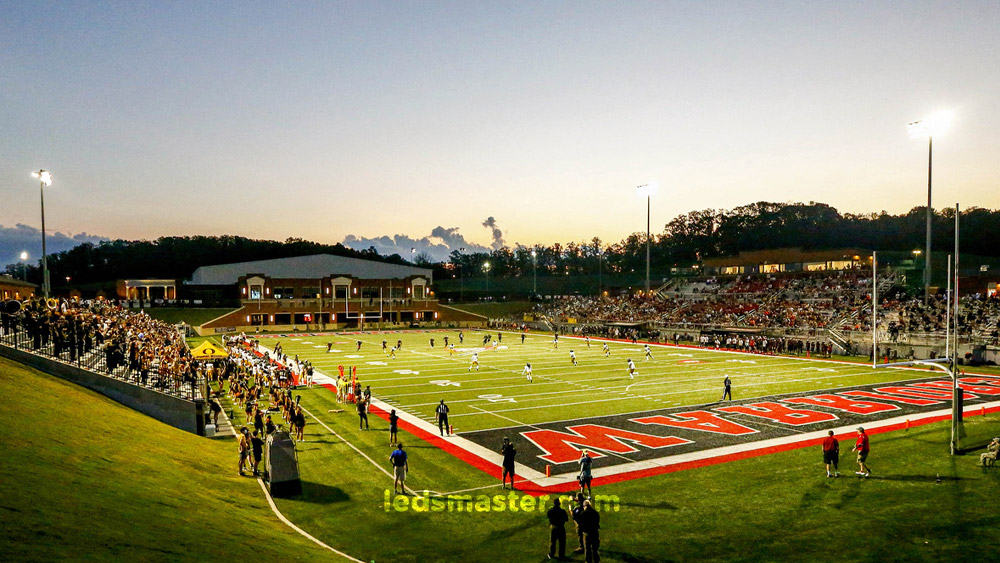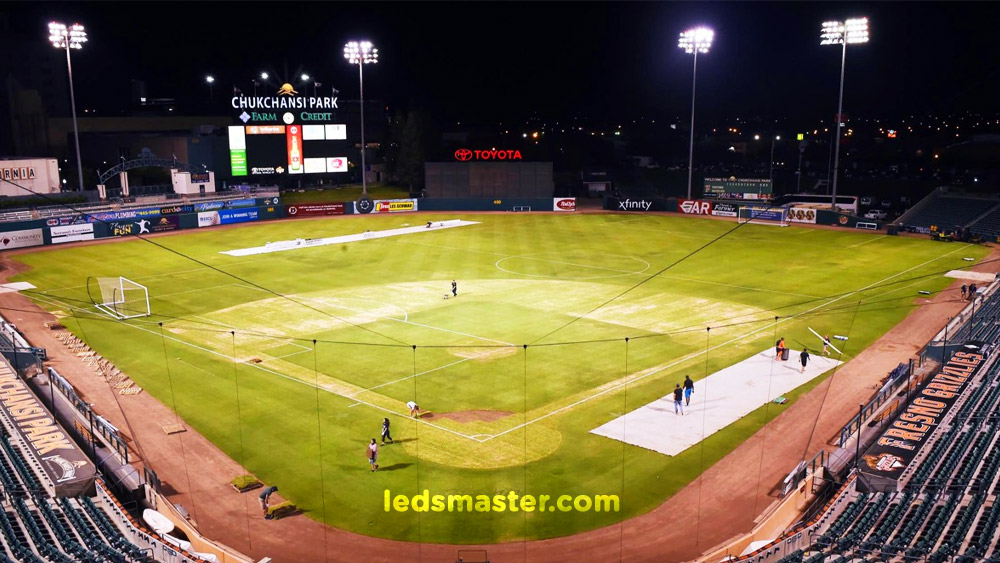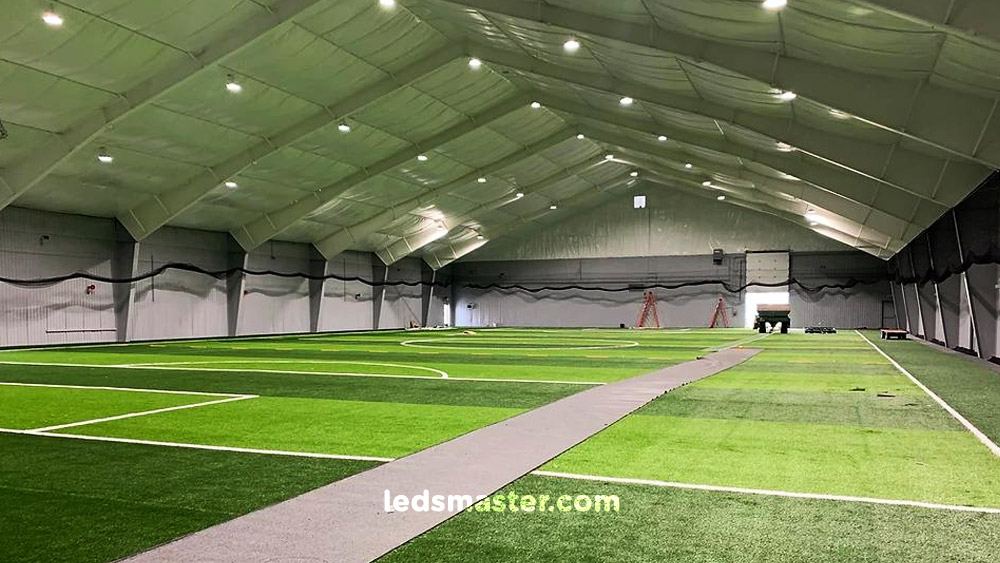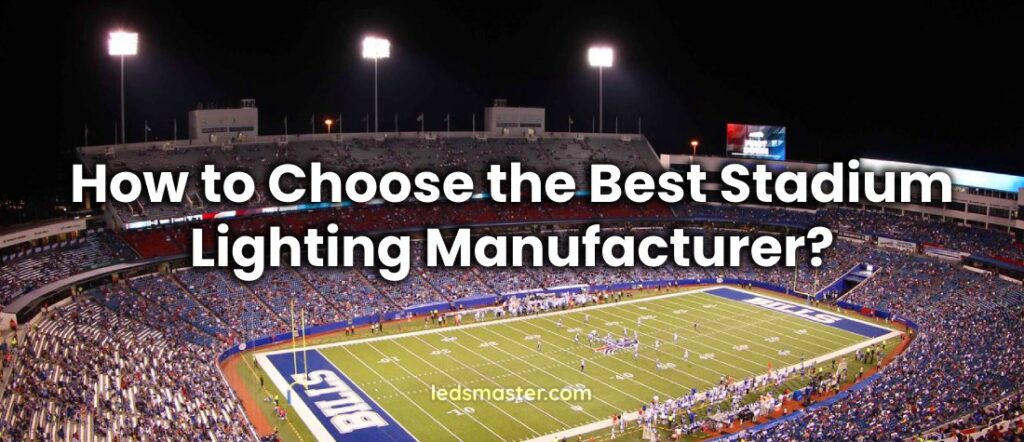Selecting the optimal LED stadium lighting supplier poses challenges due to the prevalence of substandard products like fire-prone stadium lights in the market. Opting for the wrong product not only risks financial and time losses but also undermines your credibility with customers. Here are our key recommendations for choosing the best stadium lighting manufacturer.
Traditional high-intensity discharge (HID) lamps such as mercury vapor, metal halide, and high-pressure sodium lamps have been used for stadium lighting over past centuries. However, they suffer from short lifespans and lengthy warm-up times, making them less suitable for modern stadium lighting and broadcasting needs. With advancements in the LED industry, lighting equipment now boasts improved energy efficiency and longevity. Consequently, an increasing number of stadium lighting suppliers are offering LED floodlights.
Table of Contents
ToggleThe Consequences of Choosing an Inadequate Stadium Lighting Supplier
Imagine the repercussions of selecting the least suitable stadium lighting supplier. Before delving into strategies for choosing the best LED stadium lighting manufacturer, consider the potential ramifications of opting for an inadequate provider for your football stadium lighting needs.
Failure to select the optimal football field floodlight supplier can lead to challenges in meeting critical lighting specifications such as brightness levels, uniformity across the field, appropriate color temperature, and effective anti-glare features. Consequently, you may find yourself compelled to invest additional resources in frequent replacements and maintenance of the lighting infrastructure.
It is crucial to prioritize the quality of stadium lighting fixtures, assessing factors such as the manufacturer’s construction methods and the quality of raw materials employed. These fundamentals significantly influence the durability and performance of the lighting solution.
Key questions must be addressed: What type of lighting technology does the supplier employ? What specific brightness requirements does my stadium necessitate? Understanding these foundational aspects is essential for laying the groundwork for a successful stadium lighting project. Once these needs are clearly defined, the search for a lighting manufacturer that aligns with these specifications can begin in earnest.
Visibility and Athlete Performance

Effective stadium lighting is crucial for maintaining adequate visibility on football fields, baseball diamonds, and other sporting arenas. Poor-quality lighting can result in uneven illumination, shadows, and inadequate brightness levels. This can impair athletes’ ability to judge distances, track fast-moving balls accurately, and perform at their best. Such limitations not only affect gameplay but also increase the risk of injuries due to reduced visibility, impacting both athlete safety and performance consistency.
Broadcast Quality and Viewer Experience
High-definition broadcasts of sports events rely heavily on optimal lighting conditions. Dim or improperly colored lighting with low Color Rendering Index (CRI) can distort colors and visual clarity, affecting the quality of televised sports broadcasts. This compromises the viewing experience for fans, reducing the excitement and engagement of viewers who expect crisp visuals and accurate representation of sports action. Ensuring high-quality lighting solutions is therefore essential to maintain the professionalism and appeal of televised sports events.
Community Relations and Light Pollution
Improperly designed stadium lighting can lead to light pollution and community complaints. Glare from misdirected or excessively bright stadium lights can spill into residential areas, disrupting the peace and comfort of nearby residents—especially during evening and nighttime events. This glare not only affects community relations but can also distract athletes on the field, impacting their focus and performance. Choosing a stadium lighting supplier with expertise in light control and glare reduction is crucial to minimize these negative effects and maintain positive relations with the surrounding community.
Environmental Impact and Sustainability
Opting for energy-efficient lighting solutions is not only economically advantageous but also environmentally responsible. Traditional lighting fixtures such as High-Intensity Discharge (HID), mercury vapor, and metal halide lamps consume significant amounts of electricity and require frequent replacements due to their shorter lifespans and rapid lumen depreciation. In contrast, LED stadium lights offer superior energy efficiency, potentially reducing electricity costs by 80 to 90 percent and minimizing carbon footprint. LEDs also have a longer lifespan of up to 150,000 hours, significantly reducing maintenance and replacement expenses over time. Choosing LED lighting can thus contribute to sustainability goals while enhancing operational efficiency and cost-effectiveness.
Long-term Cost Considerations
Investing in quality stadium lighting from a reputable supplier involves considering long-term cost implications. While initial costs may vary, opting for high-quality LED fixtures can lead to substantial savings over time. Lower energy consumption, reduced maintenance needs, and longer lifespan all contribute to lower total cost of ownership compared to traditional lighting options. Understanding and comparing these lifecycle costs is essential in making informed decisions that balance upfront investment with ongoing operational savings.
By partnering with a reputable LED lighting manufacturer, sports venues can not only enhance operational efficiency and reduce environmental impact but also ensure optimal lighting conditions that support peak athletic performance and viewer enjoyment.

Guidelines for Choosing the Best LED Stadium Lighting Supplier
Whether you’re in search of a supplier or manufacturer for your stadium lighting project, it’s essential to adhere to these fundamental guidelines. By following these principles, you can ensure you make the best choice for your specific needs and requirements.
1. The Relevance of Stadium Lighting Projects
When designing football field lighting, the process extends far beyond simply mounting lights on poles or stadium roofs. It’s crucial to meticulously align the lighting setup with the specific requirements mandated by the stadium owner. This ensures not only optimal visibility during events but also compliance with safety and performance standards essential for both players and spectators alike. Therefore, the choice of a seasoned stadium lighting provider becomes paramount.
Specialization in sports lighting is a key criterion to consider when selecting a supplier. General lighting companies, while capable in their own right, may lack the nuanced expertise required for complex stadium lighting designs. By opting for a provider with a dedicated focus on sports venues—ranging from football and soccer to baseball and cricket fields—you ensure they possess a deep understanding of the unique demands and challenges posed by each type of sporting environment.
Furthermore, when evaluating an LED stadium lights manufacturer, it’s prudent to delve into their track record and capabilities. A reputable supplier should demonstrate proficiency in delivering tailored lighting solutions that meet the diverse needs of different sports venues. This includes factors such as calculating the optimal number of lights required, ensuring uniformity of lighting across the field, and managing costs effectively, which can vary depending on the specific requirements and the level of competition hosted at the stadium.
2. Timeliness and Production Efficiency in Stadium Light Manufacturing
When embarking on a football stadium lighting project, the choice of lighting supplier plays a pivotal role in meeting project deadlines. The manufacturing process for stadium lights demands careful consideration of timeframes, as delays can significantly impact project outcomes. Thus, assessing the production efficiency and delivery capabilities of suppliers for soccer stadium floodlights is paramount.
A crucial factor in selecting a supplier is the lead time required for manufacturing. Typically, this can range from 15 to 45 days, contingent upon variables such as the quantity of stadium lights needed, the specifications of the LEDs, and other project-specific requirements. This timeframe ensures that the supplier can adequately plan and execute the production process to meet the project’s timeline.
Moreover, the production capacity of the supplier is equally essential. A proficient supplier of football field floodlights should demonstrate the capability to manufacture over 10,000 LED lights per month. This high production capacity not only indicates the supplier’s ability to handle large-scale projects effectively but also provides assurance that they can meet the demands of timely deliveries.
Choosing a supplier with robust manufacturing capabilities and a proven track record in timely deliveries is critical for ensuring the success of stadium lighting projects. It mitigates the risks of delays and ensures that the lighting systems are installed and operational within the specified timeframe, aligning with the overall project schedule.
3. Free Stadium Lighting Design Services
Designing stadium lighting is a critical phase for any successful project. Each stadium’s unique characteristics, such as varying light pole arrangements and lux requirements, necessitate a tailored lighting design. A one-size-fits-all approach simply won’t suffice. Therefore, it’s crucial to develop a bespoke lighting plan for each stadium.
While some stadium lighting manufacturers may charge for their design services, others, like LedsMaster, offer free stadium lighting designs. Opting for a supplier that provides this complimentary service can significantly benefit your project.
Accessing multiple free lighting designs allows for easy comparison of costs across different companies, ensuring the solution aligns with your budgetary constraints. Although reviewing numerous lighting proposals may seem labor-intensive, the effort yields valuable results. It enables you to select the optimal stadium lighting design while identifying the most suitable company to meet your project requirements.
LedsMaster, for instance, stands out by offering comprehensive free lighting designs for all sports lighting projects. Their designs specify the exact number of lights and wattages needed to effectively illuminate the field. This service is facilitated by their team of experienced engineers, who are readily available to assist with your project needs.

4. Comparing Stadium Lighting Prices and Quality
When it comes to purchasing stadium lighting, thorough comparison is crucial for making informed decisions that balance cost and quality. Gathering bids from various suppliers allows you to assess the competitiveness of their pricing.
However, it’s essential to exercise caution when encountering exceptionally low prices from stadium lighting manufacturers. Opting for a supplier offering significantly cheaper stadium lights—typically priced between $0.10 to $0.30 per watt of LED—can be risky. Such low prices often indicate compromises in quality, potentially resulting in LED lights and power supplies that fail prematurely, typically within 3 to 6 months. This scenario not only leads to operational disruptions but also necessitates additional expenditures to replace faulty equipment.
In contrast, the standard range for reliable stadium lighting typically falls between $0.50 to $1.50 per watt of LED. Investing in lights within this range ensures a balance between initial cost and long-term performance reliability.
Therefore, the cardinal rule remains: prioritize quality over the allure of low prices. By focusing on the durability, performance, and track record of the lighting solutions offered, you can safeguard your investment and ensure optimal illumination for your stadium. Always scrutinize supplier credentials, product warranties, and customer reviews to make a well-informed choice that meets both your budgetary constraints and operational needs effectively.
5. Understanding Different Types of Stadium Lighting
Stadium lighting encompasses several types, including LED, metal halide, mercury vapor, and high-pressure sodium lights. Among these options, LED lights stand out as the preferred choice for numerous reasons.
LED lights offer significant advantages over traditional lighting technologies. They are highly energy-efficient, consuming less electricity compared to metal halide, mercury vapor, or high-pressure sodium lights. This efficiency not only reduces operational costs but also aligns with sustainable energy practices, making LEDs environmentally friendly.
Moreover, LED stadium lights are renowned for their durability and longevity. Although the initial purchase cost of LED lights may be marginally higher than traditional HID (high-intensity discharge) lights like metal halide, the long-term savings from reduced energy consumption and lower maintenance costs far outweigh this initial investment. LEDs typically have a longer lifespan, requiring less frequent replacement and maintenance, which contributes to additional savings over time.
In recent years, LEDs have surged in popularity and become the dominant choice for stadium lighting. The advancement of technology has led to the development of high-power, ultra-bright LED stadium floodlights, capable of delivering superior illumination levels with enhanced efficiency and reliability.
6. Integration with Smart Lighting Systems
Integrating stadium lighting with smart technology represents a significant advancement that goes beyond traditional lighting systems. By adopting smart lighting solutions, stadiums can achieve enhanced operational efficiency and provide greater control to users. These systems enable automated scheduling based on events or time of day, facilitating precise lighting adjustments without manual intervention.
Remote monitoring capabilities offered by smart lighting systems allow stadium managers to oversee lighting performance from a centralized platform. This remote access not only streamlines maintenance but also enables proactive troubleshooting, minimizing downtime and ensuring continuous operational readiness.
Smart lighting supports sophisticated energy management strategies. By dynamically adjusting lighting levels based on real-time usage data and environmental conditions, stadiums can optimize energy consumption. This capability not only reduces utility costs but also aligns with sustainability goals by lowering overall energy usage and carbon footprint.
7. Warranty Coverage for Stadium Lighting
Having confidence in the quality of stadium lighting is paramount, but having a warranty adds essential reassurance. While ideally, top-notch stadium lights may not require warranty support due to their durability, it’s prudent for suppliers to offer extended coverage.
A reputable lighting supplier typically provides a warranty ranging from 5 to 10 years for stadium lights. This warranty serves as a safeguard against unforeseen issues that could affect the performance or longevity of the lighting system. It ensures that in case of any defects or malfunctions, repairs or replacements will be covered, minimizing potential disruptions and additional costs for the stadium management.
When selecting a stadium lighting manufacturer, it’s beneficial to inquire about options to extend the warranty period further. Some suppliers may offer customizable warranty packages to suit specific project needs or provide options for maintenance contracts beyond the initial warranty period. This proactive approach not only enhances peace of mind but also reinforces the supplier’s commitment to quality and customer satisfaction.
8. Compliance with Regulatory Standards
Ensuring compliance of stadium lighting solutions with local regulatory standards and lighting norms is paramount for several reasons. Adhering to these standards not only avoids potential fines and legal challenges but also prevents delays that can disrupt project timelines.
Local regulations govern aspects such as light pollution, energy efficiency, and safety standards. Non-compliance with these regulations can result in penalties and may necessitate costly retrofits or redesigns to meet mandated requirements. Furthermore, failure to comply with regulatory standards could lead to project delays as approvals may be withheld or revoked until issues are rectified.
9. Inquiring About Stadium Lighting
When engaging with a stadium lighting provider, it’s essential to ask a range of questions to ensure clarity and confidence in your decision-making process. A reputable supplier will readily address inquiries regarding lux levels, required wattage, installation intricacies, customization options, and more.
Through this dialogue, you not only gather crucial technical information but also gauge the reliability and transparency of the lighting companies under consideration. A willingness to answer questions demonstrates a supplier’s commitment to customer satisfaction and their expertise in stadium lighting solutions.
Conversely, reluctance or evasion in addressing queries may raise concerns about the supplier’s credibility or the quality of their products and services. Asking probing questions helps uncover any potential gaps or discrepancies early in the discussion, allowing you to make informed comparisons between suppliers.
Conclusion
Choosing the right LED stadium lighting supplier is crucial amid market challenges like unreliable products. Opting for an unsuitable supplier risks financial losses and undermines credibility. To mitigate these risks, prioritize quality and compliance with local regulations. LED technology offers superior energy efficiency and longevity, tailored to modern stadium needs. Integrating smart lighting systems enhances operational efficiency and control. By partnering with a reputable manufacturer that understands your stadium lighting needs, you can ensure both performance excellence and a positive spectator experience, securing the future success of your venue.

